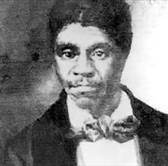The Infamous Dred Scott Ruling
In 1857, the Supreme Court rendered one of the most controversial and repugnant decisions in American history by ruling that slaves were property, not human beings.

Dred Scott
Dred Scott was a Missouri slave whose master was a U.S. army surgeon. The army transferred the surgeon to various states and territories, and he brought Scott with him. They briefly lived in the Wisconsin Territory (present-day Minnesota), where slavery was prohibited.
When the surgeon died, Scott and his family were ultimately inherited by John F.A. Sanford of New York. Scott sued Sanford for his freedom, arguing that he was entitled to freedom because he had briefly lived where slavery was prohibited according to the Missouri Compromise of 1820. That compromise had banned slavery north of Missouri, which included the Wisconsin Territory.
The case finally reached the Supreme Court in 1857, after 11 years of trials and appeals. James Buchanan became the 15th U.S. president in March of that year. In his inaugural address, Buchanan declared that the Dred Scott case and the issue of slavery ”belongs to the Supreme Court of the United States, before whom it is now pending, and will, it is understood, be speedily and finally settled.” Two days after Buchanan’s inauguration, the Court ruled 7 to 2 in Scott v. Sandford (Sanford’s name was misspelled) that Dred Scott was not entitled to freedom.
Writing the majority opinion, Chief Justice Roger B. Taney ruled that blacks were historically “so far inferior that they had no rights which the white man was bound to respect.” Thus, blacks could not be U.S. citizens, regardless of whether they were free or enslaved. To validate this point, Taney cited numerous laws limiting or prohibiting citizenship for blacks, especially in the northern states. Only states could confer citizenship on persons, not the Court.
This meant that Dred Scott could not be a U.S. citizen because he was black. Since Scott could not be a U.S. citizen, he had no right to sue in a federal court. Thus, the Supreme Court had no authority to hear such a case, and the lower court rulings that Scott was not entitled to freedom were upheld. But Taney exceeded the case’s scope by establishing two more controversial points:
First, Scott had no right to sue under the terms of the Missouri Compromise because that law was unconstitutional. This despite the fact that the validity of the law was not questioned in this case.
Second, the federal government could not confiscate slaves from their masters, even if they moved to free states, because it violated the Fifth Amendment banning federal seizure of private property without due process of law.
Thus, slaves were considered property, not persons, and the federal government could not stop citizens from bringing their property into any state or territory. This opened the path toward expanding slavery throughout the country.
The two dissenting justices issued objections to Taney’s ruling:
First, they argued that Taney should have not rendered the second part of his ruling, instead simply ending the case by ruling that it was outside the Court’s jurisdiction since Scott was not considered a citizen.
Second, they noted that the Missouri Compromise was valid because it was based on the Northwest Ordinance of 1787, which had prohibited slavery in the region around the Great Lakes, and was endorsed by most of the nation’s founders.
Third, they asserted that there was no legal basis to deny citizenship to blacks because when the Constitution was ratified, 10 of the 13 original states had allowed black suffrage. Even though black civil and voting rights had been largely curtailed since then, past recognition of black citizenship could not now be revoked.
Evidence suggests that James Buchanan helped influence the decision before becoming president in an effort to resolve the slavery issue once and for all. Buchanan had written to Justice John Catron asking his help in deciding the case before Buchanan’s inauguration. Buchanan also persuaded fellow Pennsylvanian Robert C. Grier to side with Taney to show northern support for the decision and make the verdict appear more decisive.
Ruling the Missouri Compromise unconstitutional marked just the second time that the Supreme Court had invalidated an act of Congress (the first was Marbury v. Madison in 1803). Even so, the ruling had little effect since the compromise had been effectively ended by the Kansas-Nebraska Act of 1854. Nevertheless, the decision sparked outrage among liberty advocates due to its callous definition of fellow human beings as property.
This ruling was cheered in the South and condemned in the North, thus further dividing the country. Northern antislavery advocates were horrified that slaveholders could now expand slavery throughout the new western territories, or even into the northern states. The Albany Evening Journal called the decision a victory for slavery which was an offense to the founding principle of individual freedom.
Politically, northerners feared that this could expand southern political influence in Washington and shift the balance of federal power to the South. Southern congressmen soon introduced bills to extend slavery into the territories and even to revive the African slave trade. The Democratic Party split over the ruling along North-South lines. The ruling also invalidated the Republican Party’s platform, which favored banning slavery in the western territories. This emboldened more northerners to side with the abolitionists and support the Republicans in the 1860 elections.
Financial backers purchased the freedom of Dred Scott and his family before Scott died the year after the ruling. Roger B. Taney’s reputation as a justice was irreparably harmed by this case. Also irreparably harmed was sectional harmony, as the ruling only split North and South apart even further. The decision was eventually overturned by the post-war Thirteenth and Fourteenth Amendments, which ended slavery and conferred national citizenship on all persons born in the U.S.





